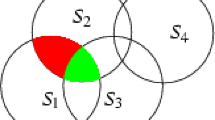Abstract
We discuss the question of portfolio selection when the returns of the assets under consideration are characterized by a heavy-tailed distribution. As distributional assumption we consider the sub-Gaussian stable model and address the problems of estimation and portfolio optimization. The advantages for risk assessment when relaxing the normal assumption in favor of the heavy-tailed variant are illustrated empirically.
Research support by the Deutsche Forschungsgemeinschaft is greatfully acknowledged.
Access this chapter
Tax calculation will be finalised at checkout
Purchases are for personal use only
Preview
Unable to display preview. Download preview PDF.
Similar content being viewed by others
References
Basle Committee (1996). Supervisory framework for the use of “backtesting” in conjunction with the internal models approach to market risk capital requirements, Basle Committee on Bank Supervision.
Doganoglu, T. and S. Mittnik (2002). Portfolio selection, risk assessment and heavy tails, unpublished manuscript, Institute of Statistics and Econometrics, University of Kiel.
Fama, E. (1963). Mandelbrot and the stable Paretian hypothesis, Journal of Business, 36, 420–429.
Fama, E. (1965a). The behavior of stock market prices, Journal of Business, 38, 34–105.
Fama, E. (1965b). Portfolio analysis in a stable Paretian market, Management Science, 11,404–419.
Gamrowski, B. and S. Rachev (1999). A testable version of the Pareto-stable CAPM, Mathematical and Computer Modeling, 29, 61–81.
Götzenberger, G., S. Rachev and E. Schwartz (2000). Performance measurements: the stable Paretian approach, Applied Mathematics Reviews, Vol. 1, World Scientific Publ., 285–327.
Hansen, G., J.-R. Kim and S. Mittnik (1998). Testing cointegrating coefficients in vector autoregressive error corrrection models, Economic Letters, 58, 1–5.
Janicki, A. and A. Weron (1994). Simulation and chaotic behavior of stable stochastic processes, New York: Marcel Dekker.
Mandelbrot, B. (1963a). New methods in statistical economics, Journal of Political Economy, 71, 421–440.
Mandelbrot, B. (1963b). The variation of certain speculative prices, Journal of Business, 26, 394–419.
Mandelbrot, B. (1967). The variation of some other speculative prices, Journal of Business, 40, 393–413.
Markowitz, H. (1959). Portfolio selection: efficient diversification ofinvestment, New York: Wiley.
Nikias, C. L. and M. Shao (1995). Signal processing with alpha-stable distributions and applications. New York: Wiley.
Ortobelli, S., S. Rachev, and E. Schwartz (2000). The problem of optimal asset allocation with stable distributed returns, Technical Report, Department of Finance, Anderson School of Management, UCLA.
Ortobelli, S., I. Huber, S. Rachev, and E. Schwartz (2000). Portfolio choice theory with non-Gaussian distributed returns, Technical Report, Department of Statistics and Applied Probability, University of California at Santa Barbara.
Owen, J. and R. Rabinovitch (1983). On the class of elliptical distributions and their applications to the theory of portfolio choice, Journal of Finance, 38, 745–752.
Paulauskas, V. and S. Rachev (2001). Maximum likelihood estimators in regression models with infinite variance innovations, to appear in Statistical Papers.
Rachev, S. and S. Mittnik (2000). Stable model in finance, Chichester: Wiley.
Rachev, S. S. Ortobelli and I. Huber (2001). Portfolio selection with stable returns, unpublished manuscript, University of Karlsruhe.
Ross, S. (1978). Mutual fund separation in financial theory-the separating distributions, Journal of Economic Theory, 17, 254–286.
Rothschild, M. and J. Stiglitz (1970). Increasing risk: L definition, Journal of Economic Theory, 2, 225–243.
Samorodnitsky, G. and M.S. Taqqu (1994). Stable non-Gaussian random processes: stochastic models with infinite variance, New York: Chapman and Hall.
Simaan, Y. (1993). Portfolio selection and asset pricing: Three parameter framework, Management Science, 5, 568–577.
Tokat, Y, S. Rachev and E. Schwartz (2001). The stable non-Gaussian asset allocation: a comparison with the classical Gaussian approach, to appear in Journal of Economic Dynamics and Control.
Author information
Authors and Affiliations
Editor information
Editors and Affiliations
Rights and permissions
Copyright information
© 2002 Springer Science+Business Media New York
About this chapter
Cite this chapter
Doganoglu, T., Mittnik, S., Rachev, S. (2002). Portfolio Selection in the Presence of Heavy-Tailed Asset Returns. In: Klein, I., Mittnik, S. (eds) Contributions to Modern Econometrics. Dynamic Modeling and Econometrics in Economics and Finance, vol 4. Springer, Boston, MA. https://doi.org/10.1007/978-1-4757-3602-1_5
Download citation
DOI: https://doi.org/10.1007/978-1-4757-3602-1_5
Publisher Name: Springer, Boston, MA
Print ISBN: 978-1-4419-5331-5
Online ISBN: 978-1-4757-3602-1
eBook Packages: Springer Book Archive




